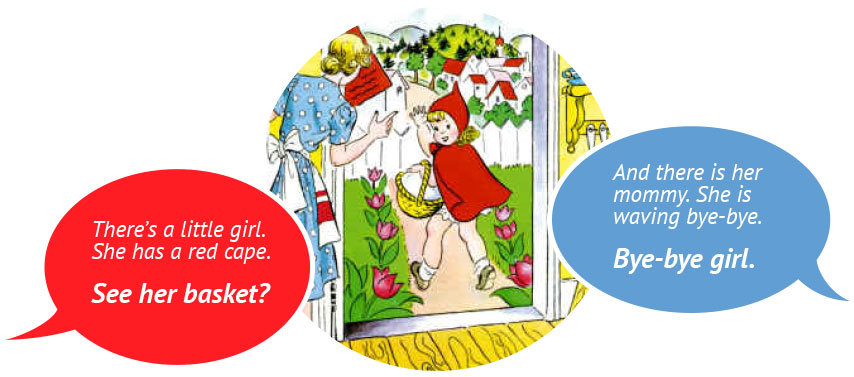Sharing books with children who are deaf or hard of hearing is very important for language development. There can be some unique challenges at first. We address some of these in sections coming up. Your persistence in book sharing will pay off!
Keep It Simple
Your baby may not be ready to pay attention to or understand the full story (like
Little Red Riding Hood below). But, you can talk about the pictures in the book and name the objects you are both looking at.

- Think about the ideas in the book, not the exact wording.
- We often talk about a book instead of reading the exact words to our hearing babies, so why shouldn't we do the same thing for our babies who are deaf or hard of hearing?
- As your child's language grows, you will shift to telling the story and later, to reading the exact words in the book.
Share the Book Over and Over
Your baby will have favorite stories before he or she walks, talks or signs. Your child will enjoy a book if:
- Your speech or signs for a certain book are especially fun or interesting.
- Your baby likes the pictures in a book.
Every time you share books, your baby's participation will grow. You may find yourself telling more and more of the story that is actually on the pages. You are building a basis for language, reading and having favorite books.
Find Ways That You Can Interact
Small children and babies like books that can be handled, dropped, chewed and looked at many times. To very young children, the stories in the book won't be nearly as important as pointing out to you all the exciting pictures, shapes and colors they notice.
- Read books with flaps that open or tabs to pull to enhance communication.
- Books that encourage sounds or gestures help parents and babies interact.
- Babies love to copy what they see and hear, and will love to watch you introduce new games.
-
Follow your baby's lead in deciding what to talk about.
- Choose books with photos and pictures of children doing familiar things (e.g., eating, going to bed, playing).
- Have sturdy books available within the child's reach, such as on a low shelf or basket.
- Choose nonfiction, informational books about food, animals, families, counting, shapes, colors, etc..
- Begin teaching that books are important and require special care.
- Read stories with text that repeats over and over and encourage your child to "chime in" on familiar parts.
- Use nursery rhymes, finger play, and music to enjoy playing with words.
- Sing and/or sign the alphabet song while going on a walk, getting dressed, or other routines.
- For a parent tip sheet, visit:
https://www.handsandvoices.org/fl3/fl3-docs/parent-take-aways/parenttake-aways_02-early-literacy.pdf